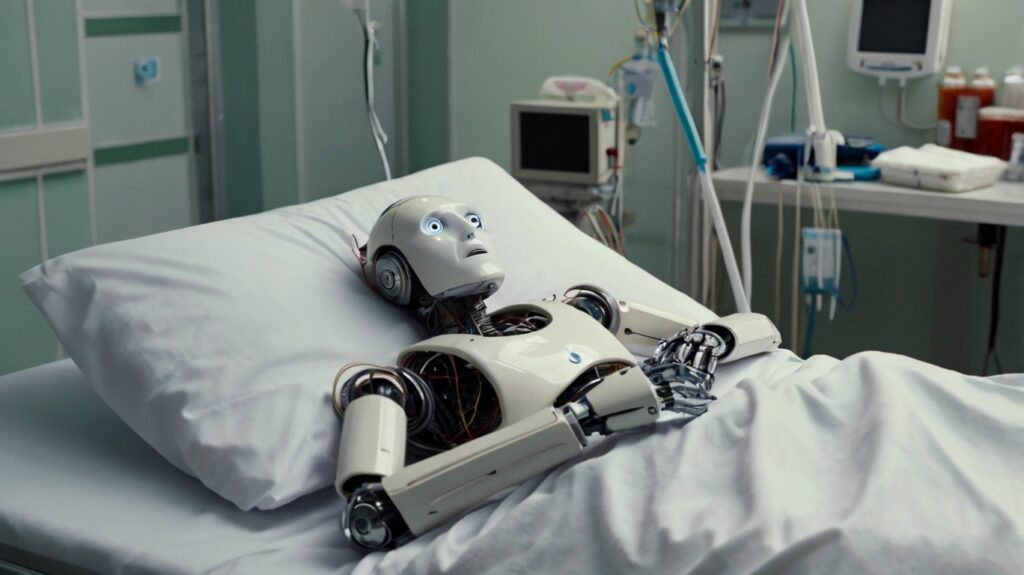
I. Introduction
The integration of artificial intelligence (AI) into healthcare, particularly in diagnostics, represents a transformative shift poised to enhance patient outcomes and streamline medical processes. As healthcare systems grapple with increasing demands for efficiency and accuracy, the latest advancements in AI offer promising tools for early detection and diagnosis of various diseases. From machine learning algorithms that analyze medical imaging to natural language processing applications that interpret clinical notes, the scope of AI in diagnostics is vast and rapidly evolving. These innovations not only augment the capabilities of healthcare professionals but also aim to reduce human error and improve resource allocation within medical settings. Consequently, an exploration of the latest research in health AI is essential to understand its potential and challenges, as well as its implication for the future of medicine. This essay will delve into the current landscape of health AI, highlighting groundbreaking developments that are shaping diagnostic practices today.
A. Overview of Health AI and its significance in modern diagnostics
The integration of health AI into modern diagnostics marks a significant advancement in the ability to deliver accurate, efficient, and personalized medical care. By leveraging sophisticated algorithms, particularly through deep learning techniques such as Convolutional Neural Networks (CNNs), AI enhances diagnostic processes across various fields, including radiology and dentistry. The precision with which AI can analyze vast datasets, including medical images, has transformed the way healthcare professionals approach diagnosis and treatment planning. For instance, AI systems excel in identifying critical features in radiographs and intraoral examinations, resulting in more reliable diagnoses and streamlined workflows (Gargouri et al.). Furthermore, health AIs role extends beyond image analysis; it supports clinical decision-making, thereby fostering individualized treatment plans based on comprehensive patient data (Hospital AKU et al.). This capability not only improves patient outcomes but also addresses challenges related to data management and clinical efficiency, positioning health AI as a transformative force in modern diagnostics.
II. Advancements in AI Algorithms
Recent advancements in AI algorithms have significantly enhanced diagnostic capabilities in healthcare, particularly through the integration of sophisticated models that analyze complex medical data. By employing algorithms such as machine learning and deep learning, researchers have developed systems capable of identifying patterns within vast datasets, facilitating early disease detection and personalized treatment plans. For instance, the utilization of heart sound analysis through AI has led to the proposal of innovative algorithms that estimate heart sound splitting, providing crucial insights into cardiac function and disease progression (Luo et al.). Moreover, the adoption of such algorithms is increasingly guided by success factors identified in recent studies, which highlight the importance of organizational capabilities and environmental conditions, ultimately promoting the AI integration process in clinical practice (Chen et al.). As these algorithms evolve, they promise to revolutionize diagnostic research and patient monitoring, leading to improved health outcomes and more effective healthcare delivery.
A. Machine Learning Techniques in Disease Detection
The application of machine learning techniques in disease detection is revolutionizing the diagnostics landscape, enabling earlier and more accurate identification of health conditions. These algorithms analyze vast datasets, extracting patterns that may not be discernible to human practitioners. For instance, research has demonstrated the efficacy of artificial intelligence in detecting arrhythmias by utilizing heart rate variability (HRV) technology, which can effectively analyze various cardiac conditions even in patients with differing arrhythmia levels (Marchitto et al.). Furthermore, the integration of advanced wireless technologies, such as 5G, facilitates seamless connections among devices and accelerates data processing capabilities, which are essential for real-time diagnostics (Farooq et al.). This intersection of machine learning and cutting-edge technology not only enhances diagnostic accuracy but also aims to create a more equitable healthcare system, consistent with global health initiatives. Collectively, these innovations underscore the potential for health AI to dramatically improve patient outcomes.
III. Impact on Patient Outcomes
The integration of artificial intelligence (AI) in healthcare is poised to significantly enhance patient outcomes, particularly through improved diagnostic accuracy and personalized treatment plans. By leveraging advanced algorithms and big data, AI can analyze vast amounts of patient information, enabling clinicians to identify potential health risks earlier and with greater precision. This is especially critical in emergency settings, where timely interventions can drastically alter patient trajectories, as seen in acute heart failure (AHF) management, where misdiagnosis can lead to adverse events and increased healthcare costs (Bueno et al.). Furthermore, the deployment of AI, along with emerging technologies such as 5G, ensures equitable access to quality healthcare—addressing long-standing inefficiencies within the system (Farooq et al.). As we continue to explore the intersection of technology and medicine, it becomes increasingly evident that these innovations are central to revolutionizing patient care and improving overall health outcomes.

A. Case Studies Demonstrating Improved Diagnostic Accuracy
Recent case studies illustrate the transformative impact of artificial intelligence on diagnostic accuracy across various medical fields. For instance, in cardiovascular medicine, the integration of machine learning algorithms with heart rate variability (HRV) data from mechanical circulatory support (MCS) devices has shown promising results.
Researchers have demonstrated that HRV can serve as a dynamic biomarker, enhancing predictions regarding patient responses to device therapy and improving outcomes for those suffering from congestive heart failure (Aras et al.). Similarly, advancements in endodontics reveal that AI-driven models, particularly convolutional neural networks, can effectively analyze root canal anatomy and detect early-stage periapical lesions, thereby facilitating timely interventions and accurate treatment success predictions (Asgary et al.). These case studies underscore the potential of AI not only to improve diagnostic accuracy but also to redefine patient management strategies in diverse healthcare settings.
IV. Conclusion
In conclusion, the integration of artificial intelligence within healthcare diagnostics represents a transformative shift with the potential to address various systemic deficiencies. As highlighted in the context of global health initiatives, the convergence of technologies such as AI, IoT, and 5G will play a pivotal role in revolutionizing healthcare delivery, ensuring equitable access to quality services as emphasized in the UN Sustainable Development Goals (Farooq et al.). Furthermore, advancements in large language models like ChatGPT unveil new avenues for enhancing diagnostic accuracy and facilitating effective doctor-patient communication, particularly in specialized fields such as dentistry (Ahmadi et al.). By leveraging these innovations, stakeholders in the healthcare sector can not only improve patient outcomes but also create a more resilient and adaptive healthcare system. Moving forward, ongoing research and development are essential to navigate the challenges that accompany this promising technological evolution, ensuring that AI serves as a catalyst for positive change in diagnostics.
A. Future Directions and Ethical Considerations in Health AI Diagnostics
As health AI diagnostics continue to evolve, future directions must be carefully navigated alongside ethical considerations. The integration of advanced algorithms and machine learning in diagnostic processes promises to enhance accuracy and efficiency; however, this innovation raises significant concerns regarding data privacy and algorithmic bias. Ethical frameworks must be established to ensure transparency in how AI systems make decisions, thereby fostering trust among both healthcare providers and patients. Moreover, as the reliance on AI tools grows, practitioners must be vigilant about potential disparities in healthcare access that could be exacerbated by unequal technology distribution. By prioritizing inclusive practices and stringent data protection policies, stakeholders can strive to create a health system where AI not only improves diagnostic outcomes but also adheres to the principles of equity and accountability. Ultimately, responsible development in health AI is essential for harnessing its full potential in improving patient care and trust in the healthcare system.
References:
- Aras, Shravan, Khalpey, Zain, Lin, Theodore. “Heart Rate Variability: A possible machine learning biomarker for mechanical circulatory device complications and heart recovery”. DigitalCommons@TMC, 2020, https://core.ac.uk/download/287891095.pdf
- Asgary, Saeed. “Artificial Intelligence in Endodontics: A Scoping Review”. Iranian Center for Endodontic Research, 2024, https://core.ac.uk/download/618356561.pdf
- Farooq, Shahzad, Imran, Muhammad Ali, Latif, Siddique, Qadir, et al.. “How 5G wireless (and concomitant technologies) will revolutionize healthcare?”. ‘MDPI AG’, 2017, https://core.ac.uk/download/143476480.pdf
- Ahmadi, Mohsen, Irankhah, Elyas, Nia, Masoumeh Farhadi. “Transforming Dental Diagnostics with Artificial Intelligence: Advanced Integration of ChatGPT and Large Language Models for Patient Care”. 2024, http://arxiv.org/abs/2406.06616
- Gargouri, Mourad. “Artificial intelligence and orthodontic : achievements, expectations and challenges”. 2024, https://core.ac.uk/download/621568864.pdf
- Aga Khan University Hospital, Karachi. “LABRAD : Vol 46, Issue 4 – October 2021”. eCommons@AKU, 2021, https://core.ac.uk/download/482026963.pdf
- Marchitto, N., Martynenko, A., Ostropolets, S., Raimondi, et al.. “Artificial intelligence for heart rate variability analyzing with arrhythmias”. ‘Kharkiv Medical Academy of Postgraduate Education KHMAPO’, 2019, https://core.ac.uk/download/231747390.pdf
- Bueno, Hector, Collins, Sean P, DI SOMMA, Salvatore, Diercks, et al.. “The role of the emergency department in the management of acute heart failure: an international perspective on education and research”. ‘SAGE Publications’, 2015, https://core.ac.uk/download/54537472.pdf
- Chen, Hong. “Success Factors Impacting Artificial Intelligence Adoption — Perspective From the Telecom Industry in China”. ODU Digital Commons, 2019, https://core.ac.uk/download/227561316.pdf
- Luo, Hongxing. “Heart sounds:From animal to patient and Mhealth”. Maastricht University, 2022, https://core.ac.uk/download/565564949.pdf
